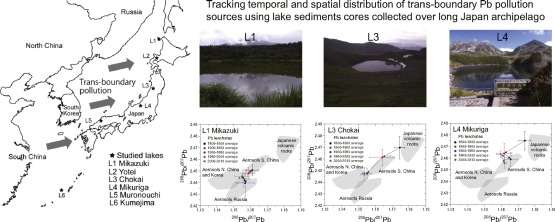Anthropogenic, trans-boundary lead pollution in Japanese lakes

Research from Kumamoto University in Japan has shown that trans-boundary lead (Pb) pollution has occurred at multiple areas across Japan. The research team, led by Professor Takahiro Hosono, has demonstrated that the lead accumulation rate in Japanese lakes had increased between the years of 1900 to 2009 by using a constant rate of supply (CRS) model.
The research team began examining lake sediment core samples from the deepest areas of six lakes from around Japan between July of 2009 and September of 2010. The selected lakes were on the western side of Japan, away from human activities, and not in active volcanic areas. Core sections were cut on site and stored in plastic bags inside cold storage until Pb analysis could be performed.
"Much of the world stopped using leaded gasoline in the 1970s and tightened industrial emission regulations in the 1980s. Since then, lead contamination in western countries has been on a constant decline." said Professor Hosono. "However, our recent research and research from other institutions shows that lead concentrations in Japan are not decreasing and, in some areas, are actually still increasing."
Even though Japan has strict lead emissions controls, the country is East of continental East Asia, much of which is experiencing heavy industrialization, meaning that prevailing winds can blow pollution from the Asian mainland to the Japanese archipelago. To determine if the contaminants were coming from across the Sea of Japan, Professor Hosono's team plotted the Pb isotope ratios (lead-206/lead-207 and lead-208/lead-207) from the lake sediment cores against samples taken from various areas in Japan, China, Russia, South Korea, and Taiwan. They found that the majority of Pb isotope data from the lake cores matched the samples taken from Russia and China. The two countries continued to be sources for trans-border pollution at least through the time the lake samples were taken. Furthermore, it was found that pollutants from Russia began around 1900 but has since been overtaken by pollution from China in the past couple of decades.
More information: Takahiro Hosono et al, Lead isotope ratios in six lake sediment cores from Japan Archipelago: Historical record of trans-boundary pollution sources, Science of The Total Environment (2016). DOI: 10.1016/j.scitotenv.2016.03.138
Journal information: Science of the Total Environment
Provided by Kumamoto University




















